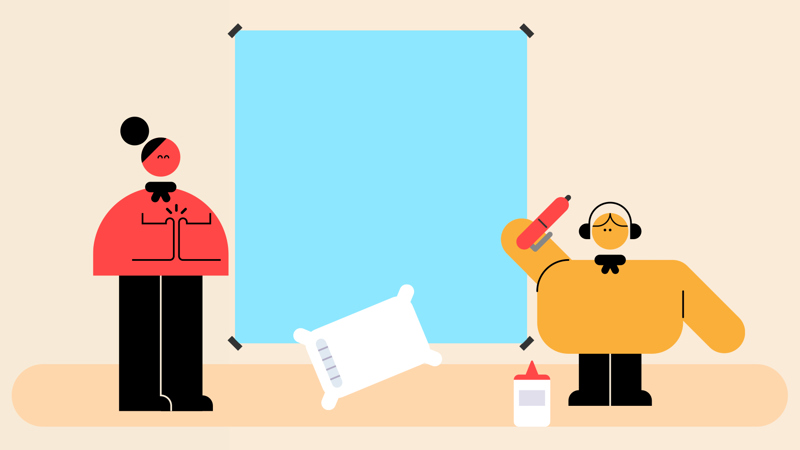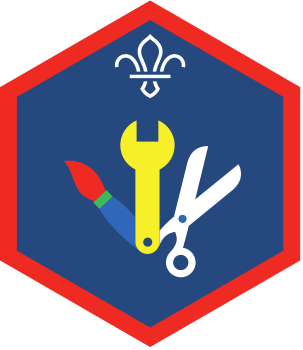
Bedsheet backdrops
You’ll need
- Big pieces of paper
- Access to water
- Coloured pens or pencils
- Craft materials (for example, tissue paper, pipe cleaners, stickers)
- Paint
- Paint brushes
- Iron
- Ironing board
- Something to protect surfaces (for example, newspaper or tablecloths)
- Scissors
- Stapler
- Basic sewing kit
- Old sheets
- Fabric markers
Before you begin
- Think about the materials you’ll use. If you don’t have space to dry the backdrops, for example, you may need to stick to sewing and fabric markers. Otherwise, you could experiment with glue or paints.
Plan and prepare
- The person leading the activity should ask everyone to find an unwanted sheet, duvet cover, blanket, or curtain (basically – a large piece of material). Plain is best.
- Everyone should wash, dry, and iron their sheet at home. An adult should confirm that they’ve learned to do everything.
Design your backdrops
- The person leading the activity should check that everyone’s got a clean, ironed sheet. They should hand out any spares, and support anyone who still needs to learn or show their ironing skills.
- Everyone should split into groups.
- Each group should decide the purpose of their backdrops. Is there a performance coming up that needs scenery? Is everyone getting ready for an open day or camp? Does the usual meeting place need a bit of livening up?
- Each group should design their backdrops on A3 paper and decide what materials they’ll use.
- Each group should decide how they’ll hang their backdrops. Will they make brackets? Could they hang from the ceiling? Will they pin them to walls or display boards? Everyone should make sure their design works with this decision – they may need to include space to add pins or rope, for example.
Decorate your backdrops
- Everyone should lay out newspaper to protect the surface they’ve using. Depending on their group, they may work on the floor, on a table, or even hanging the sheet up somewhere.
- Everyone should flatten out their sheet on their protected surface.
- Everyone should use their design to start decorating their backdrop. They may want to sketch the overall design out first, before they get stuck in with paint, fabric, or pens.
- Everyone should put their backdrop somewhere sensible to dry – it should be somewhere it won’t get in the way of other people using the meeting place (and will be kept safe).
Reflection
This activity was all about developing skills. What skills did everyone use to make their backdrop? There were practical skills like washing and ironing, as well as creative skills and teamwork too. Did anyone find any parts of the activity tricky? What other skills could they use to improve their meeting place? Perhaps people have ideas for some DIY projects they could use, maybe someone else is a talented artist, writer, or graphic designer.
This activity was also a chance to improve wellbeing. Making backdrops was a chance to take pride in the environment. How else can people take pride in the places they spend a lot of time, for example, rooms at home or classrooms at school? It can be tricky if people don’t feel so great, but making little changes like tidying up a bit of mess can help boost mood. How does it feel to have some ownership over the meeting place? How else can people express a bit of their personality through their meeting place? How does a clean, tidy, well-decorated meeting place affect the wellbeing of the people who use it?
Safety
All activities must be safely managed. You must complete a thorough risk assessment and take appropriate steps to reduce risk. Use the safety checklist to help you plan and risk assess your activity. Always get approval for the activity, and have suitable supervision and an InTouch process.
- Scissors
Supervise young people appropriately when they’re using scissors. Store all sharp objects securely, out of the reach of young people.
- Glue and solvents
Always supervise young people appropriately when they’re using glue and solvent products. Make sure there’s plenty of ventilation. Be aware of any medical conditions that could be affected by glue or solvent use and make adjustments as needed.
Challenge people to create a wooden frame or bracket so the backdrops stand on their own. This adds another level of technical expertise – you could even link it in with the DIY Activity Badge.
Anyone who’s a keen sewer could use appliqué. The finished result could be reused as a tablecloth or blanket, or turned into cushion covers.
Set each backdrop up at a level that everyone can reach. Some groups may prefer it to be on the floor, while others may need it on a table or even hanging up.
Add a tactile twist using hot glue (plus an adult to supervise) and materials including bubble wrap, embroidered fabric, and beads. A multi-sensory backdrop is a great way to explore tactile art.
All Scout activities should be inclusive and accessible.
Why not theme the backdrops as part of another badge you’re working towards?
This activity is a great chance to start a discussion about things people would like to change in their meeting place. Could they make any of the changes themselves? Perhaps some would even count towards the Scouts DIY Activity Badge.
This activity gives everyone the chance to get creative and adapt their meeting place to suit them.



